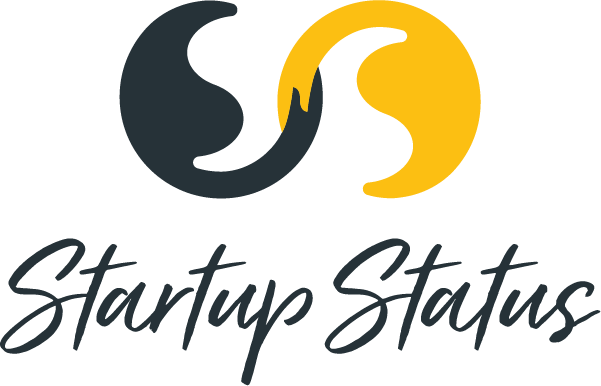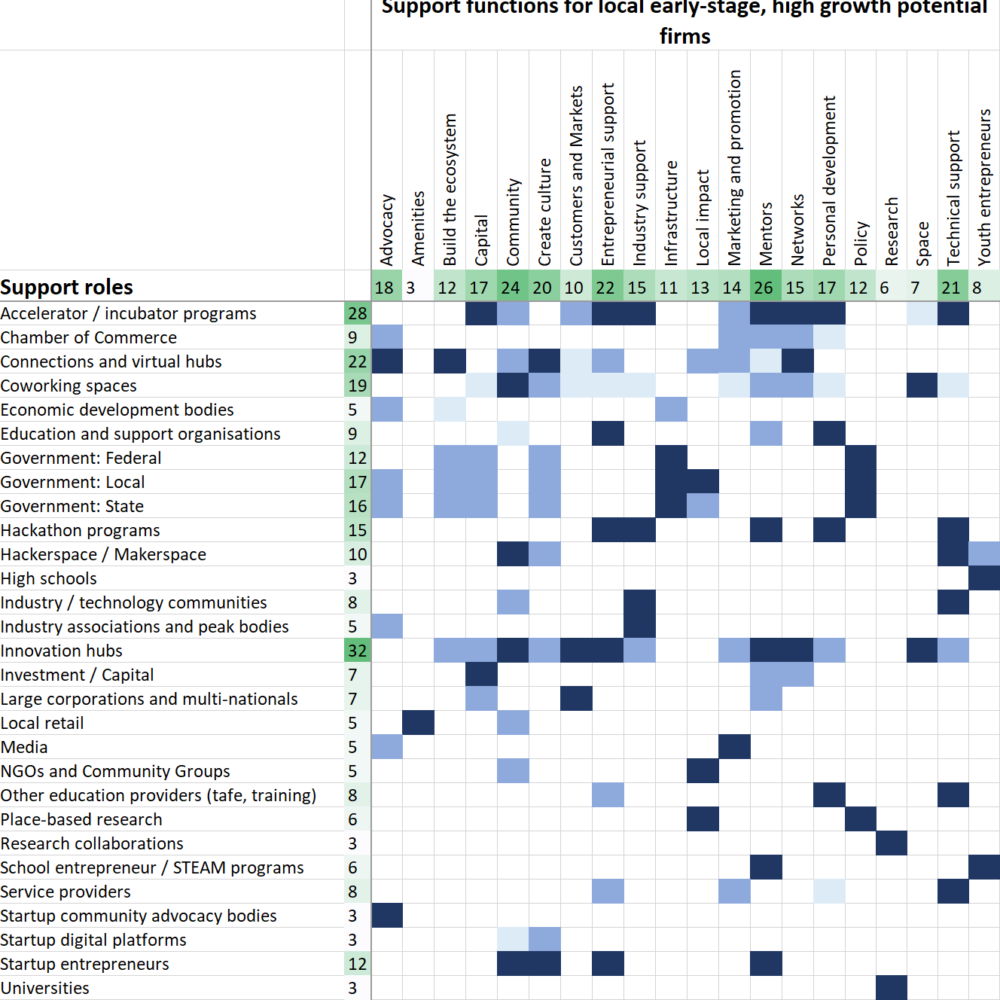Who does what to support entrepreneurs in an innovation ecosystem? Do they do it well? How does it change between regions?
While there is increasing awareness about the concept of innovation ecosystems, there remains uncertainty about who does what to support early-stage entrepreneurs. The distinction between role and function is an area I continue to explore as I deep dive into the systems that support entrepreneurs in non-metro areas.
An innovation ecosystem can be considered as roles and functions. Roles are filled by people and organisations and include investor, media, coworking space, university, and government. Functions are performed by roles and include providing access to talent, mentoring, providing capital, developing policy, and building infrastructure.
The two perspectives can blur, and lines are not clear-cut particularly in regional areas where one role does more functions due to lower density and lack of specialisation. A local Chamber of Commerce or service provider may provide coworking space, mentoring, and policy input in the absence of local government economic development staff. State government and local entrepreneurs may play a more active role in infrastructure such as internet access. Multiple parties can be involved in research.
The notion of mapping role and function was a focus of the recent release of a map of Australian innovation ecosystem actors. The distinction was explored further on a recent tour of regional Queensland to explore how entrepreneur support varies by region.
I am now taking time out following the first leg of the tour to transcribe and review around 160 interviews, around 6,400 hours, or thirteen 8-hour days of content. As I code the interviews, I identify how respondents refer to their own roles and the roles of others in the community, the functions provided, and the perceived value given and received.
Do they call themselves an entrepreneur? Identify with the local university? Take on the role of local government? The questions are answered as our conversation follows a semi-structured path through strengths of the region, the challenges experienced, the vision for the future, and potential changes needed.
This begins to form a framework for assessing regions, building on what others have done before. I previously posted about other ecosystem models including the Aspen Network’s Entrepreneurial Ecosystem Diagnostic Toolkit and the Regional Entrepreneurship and Development Index (REDI). Other place-based survey approaches include the Global Entrepreneurship Monitor and Startup Genome. The Regional Australia Institute provides the [In]Sight report for Australia’s Regional Competitiveness Index. The MIT Regional Entrepreneurship Acceleration Program (REAP) is like an accelerator program for the region itself to create the framework for competitiveness. Other audit-type models and frameworks have been around for some time, such as the Council on Competitiveness Illuminate Asset Mapping Roadmap. SourceFinder by US based SourceLink maps function by individual actor in an online tool.
The aim is not to recreate a model, but to see how people identify with the roles and functions without being given a box to place themselves into. The outline below is more of a thinking framework to describe a region’s innovation ecosystem. It describes roles in the ecosystem and functions provided specific to support for early-stage, high growth potential entrepreneurs.
The numbers are indicative to test the approach and not necessarily an assessment of the whole. There could be multiple roles that offer space, or none in a region. Universities may focus on research, or provide extensive entrepreneur support. There are some generalisations that can be made, like innovation hubs being purpose built to support entrepreneurs or coworking spaces always offering space.

Roles
Most of the roles are outlined in detail in a previous post describing the Australian innovation ecosystem map. There is some cross-over, such as an innovation hub that typically also acts as coworking, a virtual hub that provides education and support, or a university that performs place-based research.
Each role is a collection of assumed functions. These functions vary region to region, as well as the quality of how the functions are delivered. Some Chambers of Commerce focus on advocacy, while others focus on networking. Local governments with larger economic development teams may focus on entrepreneur education and support, while in other regions those functions are performed by universities or innovation hubs. Innovation hubs will have different levels and types of support based on the local leader in the hub.
- Accelerator / incubator programs
- Chamber of Commerce
- Connections and virtual hubs
- Coworking spaces
- Economic development bodies
- Education and support organisations
- Government: Federal
- Government: Local
- Government: State
- Hackathon programs
- Hackerspace / Makerspace
- High schools
- Industry / technology communities
- Industry associations and peak bodies
- Innovation hubs
- Investment / Capital
- Large corporations and multi-nationals
- Local retail
- Media
- NGOs and Community Groups
- Other education providers (tafe, training)
- Place-based research
- Research collaborations
- School entrepreneur / STEAM programs
- Service providers
- Startup community advocacy bodies
- Startup digital platforms
- Startup entrepreneurs
- Universities
Functions
A brief description of functions are outlined below. These are being further expanded and tested as part of the PhD thesis which will come out towards the end of the year. This list is by no means definitive and variations will emerge as soon as I hit publish.
- Advocacy: Advocating on behalf of startups and early-stage entrepreneurs
- Amenities: Local support system that improves the overall lifestyle, such as tourism and food retail.
- Build the ecosystem: Building and bringing together the roles and support network and system of investors, entrepreneurs, hubs, programs, etc.
- Capital: Providing investment and funding.
- Community: Bringing together communities of practice around entrepreneurial, industry, and technical groups.
- Create culture: Building the entrepreneurial culture as compared to traditional service-based and salary focused mindsets.
- Customers and Markets: Access to customers, markets, and supply chains for new entrepreneurial products and services.
- Entrepreneurial support: Content and support specific to entrepreneurial capability and capacity, such as mindset or rapid growth and scale.
- Industry support: Content and support specific to industry sectors such as agriculture or resources.
- Infrastructure: Provision of effective transportation, logistics, and internet that can support entrepreneurs focused on global markets.
- Local impact: Emphasis on applying entrepreneurial focus on local challenges and opportunities, in addition to identifying opportunities for application in similar challenges in other regions.
- Marketing and promotion: Getting the word out about the local entrepreneur through case studies, awards programs, and other promotional activities.
- Mentors: Individuals who can provide technical, business, industry, and personal coaching support.
- Networks: Access to networks not otherwise available, sponsoring the entrepreneur into new circles through introductions and acting as a “boundary spanner” across geographic, industry, technical, and socio-economic class circles.
- Personal development: Support for developing new skills and overall mental health towards an entrepreneurial mindset.
- Policy: Developing policy related to entrepreneurial activities, indicated by ease of starting a business, procurement with large institutions, and development and trial of new technologies.
- Research: Developing new technologies that can be accessed by entrepreneurs for shared IP from commercialisation.
- Space: Physical space from which to work that is accessible by entrepreneurs, typically similar to a coworking space with short term or day by day access and inherent community and collaboration opportunities.
- Technical support: Support for technical skills and people with technical skills required for the entrepreneur’s business.
- Youth entrepreneurs: Emphasis on developing entrepreneurial capability in young people.
Roles and functions: An asset mapping process
Roles can be assessed to determine how well they perform each function. For a region wanting to get started, a back of the napkin assessment can identify key actors in roles and how effectively functions are performed. The framework also brings others in the community into the conversation to discuss gaps and opportunities.
For each role in a given region, the extent that the function is served can be considered specific to supporting early-stage, high growth potential entrepreneurs. This can be done with a simple number rating such as 1 to 5.
This can then identify strengths and gaps in roles in a region. What role does the local media play in advocating entrepreneurs? Do the major economic development bodies support early-stage startups or only large-scale infrastructure projects or industry attraction for major corporates? Does the local Chamber focus on high-growth potential companies, or is the majority of the effort on buy local campaigns?
Is one role filling a gap where others could more effectively lead? Is there excessive competition in some areas that could be used to encourage roles to expand services into gaps? How does this vary between regions?
The process can also identify functions that may not be served. Is entrepreneurial culture being driven by anyone in the region? Do entrepreneurs have support in areas of personal development, technical capability, and specific industries? Do entrepreneurs have a space to gather, be it a designated coworking space or innovation hub, or a proxy of the local café or pub?
The role of the innovation hub in building community resilience
More than a thought experiment, the aim of the research project is to better understand the role of the innovation hub in building resilience, particularly in regional communities. We have seen an explosion in innovation hubs and related coworking spaces along with corresponding investment in early-stage, often tech-based companies. The aim is to ensure the investment is as effective as possible.
Another goal of the research is to understand what functions an innovation hub serves in relation to other roles in a region towards developing community capability. What we are finding is that the context in which the hub operates plays a critical role in the effectiveness of the hub. Contributing conditions include other organisations offering related functions, which organisations support or oppose the hub, and the quality and strength of the hub leadership, among other factors.
Innovation ecosystems are complex. The challenge is to present a model that accomodates the complexity to help make decisions, without reducing the situation to the point where it no longer represents reality. While I expect we are still not there, this is one step towards finding that balance.
Feedback welcome
As always, I post to share thoughts for others to benefit, test my perspectives and gain feedback, and identify others working on similar projects. Please reach out and connect if any of those descriptions apply to you. If you are inclined, I ask you to share for others that may benefit.

